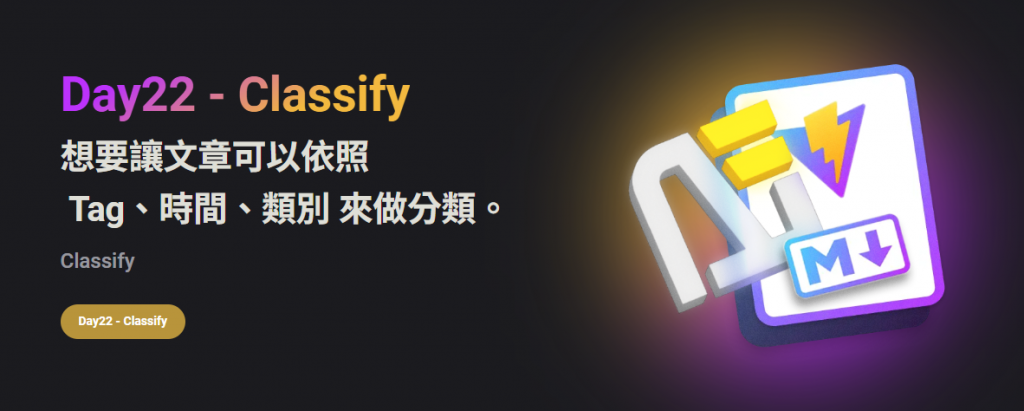
自動化側邊欄目錄之後,接下來想做文章檢索的功能,比如我想看某個特定主題的文章有哪些之類的,所以今天要依照標籤、類別、時間、發文時間、更新時間等 frontmatter 來做歸類成資料集合。
歸類 function 設計
我們一樣在 docs/.vitepress/hooks/ 目錄下新增檔案 useArticleClassification:
ts
import path from 'node:path';
import fs from 'node:fs';
import matter from 'gray-matter';
const isDirectory = (path: string) => fs.lstatSync(path).isDirectory();
function getFrontMatter(filePath: string) {
const content = fs.readFileSync(filePath, 'utf-8');
const { data } = matter(content);
return data;
}
interface iTags {
[key: string]: {
count: number
group: {
title: string
category: string
date: string
url: string
}[]
}
}
export interface iClassification {
tags: iTags
}
export async function getArticleClassification(files: string[], startPathName: string, res: iClassification | null = null): Promise<iClassification> {
if (!res) {
res = {
tags: {},
};
}
for (const file of files) {
const dir = path.join(startPathName, file); // 組合路徑
const isDir = isDirectory(dir); // 判斷是否是資料夾
if (isDir) { // 如果是資料夾,遞迴進下一次
const nextfiles = fs.readdirSync(dir);
res = await getArticleClassification(nextfiles, `${startPathName}/${file}`, res);
} else {
const fileName = path.basename(file);
// 排除非md檔案
const suffix = path.extname(file);
if (suffix !== '.md') {
continue;
}
const frontmatter = getFrontMatter(`${startPathName}/${fileName}`);
if (frontmatter.tags && frontmatter.isPublished) {
const url = `${startPathName.split('\pages')[1]}/${fileName.replace('.md', '.html')}`;
for (const tag of frontmatter.tags as string[]) {
res.tags[tag] = res.tags[tag] ?? { count: 0, group: [] };
res.tags[tag].count++;
res.tags[tag].group.push({
title: frontmatter.title as string,
iamge: frontmatter.image as string | '',
category: frontmatter.categories as string | '',
date: frontmatter.createdAt as string | '',
url
});
}
}
}
}
return res;
}1
2
3
4
5
6
7
8
9
10
11
12
13
14
15
16
17
18
19
20
21
22
23
24
25
26
27
28
29
30
31
32
33
34
35
36
37
38
39
40
41
42
43
44
45
46
47
48
49
50
51
52
53
54
55
56
57
58
59
60
61
62
63
64
65
66
67
68
69
70
71
72
73
74
2
3
4
5
6
7
8
9
10
11
12
13
14
15
16
17
18
19
20
21
22
23
24
25
26
27
28
29
30
31
32
33
34
35
36
37
38
39
40
41
42
43
44
45
46
47
48
49
50
51
52
53
54
55
56
57
58
59
60
61
62
63
64
65
66
67
68
69
70
71
72
73
74
透過和昨天類似的方式把 Tags 整理起來。 之後如果要做時間線、分類等歸類方式,也都可以在這邊擴充。
Config 設定
然後我們在 config 中加入他,然後擴充原先 DefaultTheme.Config 的型別:
ts
import { getArticleClassification, iClassification } from '../hooks/useArticleClassification';
const startPathDir = path.resolve(__dirname, '../pages'); // 把pages 設定成根目錄
const mdFiles = fs.readdirSync(startPathDir); // 讀取目錄下的文件&目錄
interface iThemeConfig extends DefaultTheme.Config {
classification: iClassification
}
const classification = await getArticleClassification(mdFiles, startPathDir);
export default defineConfig({
themeConfig: {
classification,
} as iThemeConfig,
});1
2
3
4
5
6
7
8
9
10
11
12
13
14
15
16
2
3
4
5
6
7
8
9
10
11
12
13
14
15
16
文章裡要使用
把資料塞進 frontmatter
yaml
title: 'Enum 使用實例'
author: 'Opshell'
createdAt: '2024/08/10'
categories:
- 使用實例
tags:
- typescript
editLink: true
isPublished: true1
2
3
4
5
6
7
8
9
2
3
4
5
6
7
8
9
使用 classification
資料整理好後,由於我們把他塞在 themeConfig 裡面,所以我們可以透過 useData().theme 得他,我們在擴充後的 Layout 使用他吧。
vue
<script>
import { useData } from 'vitepress';
const { theme } = useData();
const classification = theme.value.classification;
</script>
<template>
<Layout>
<template #aside-ads-after>
<div class="tag-box">
<a
v-for="(info, tag) in classification.tags"
:key="`tag-${tag}`"
class="tag"
:href="`/tags-list.html?tag=${tag}&page=1`"
>
<span>{{ tag }}:</span>
<span class="count">{{ info.count }}</span>
</a>
</div>
</template>
</Layout>
</template>1
2
3
4
5
6
7
8
9
10
11
12
13
14
15
16
17
18
19
20
21
22
23
24
25
2
3
4
5
6
7
8
9
10
11
12
13
14
15
16
17
18
19
20
21
22
23
24
25
小結
這樣在我們的文章右下角,就會出現整個網站有的 tag 和相關的文章數量啦~

